Introduction
The Minoans, a Bronze Age civilization that thrived on the island of Crete around 2000-1450 BCE, remain one of history’s most fascinating cultures. Known for their intricate palaces, advanced societal structures, and mysterious disappearance, the Minoans hold secrets that continue to intrigue historians and archaeologists.
In this blog, we’ll explore who the Minoans were, their unique contributions to history, and how their influence shaped the ancient Mediterranean. From their architectural marvels to their vibrant artwork, every aspect of Minoan life offers valuable insights into early human civilization.
Whether you’re a history enthusiast or simply curious about ancient cultures, this guide will take you on a journey through Minoan society, uncovering what made them extraordinary.
Who Were the Minoans?
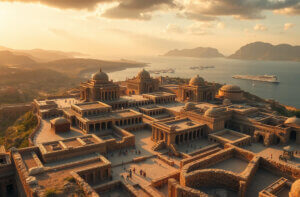
The Minoans were a Bronze Age civilization that emerged on the island of Crete, flourishing for nearly five centuries. They are named after the mythical King Minos, associated with the famous labyrinth and Minotaur legend.
Unlike many ancient societies, the Minoans were not centralized around a single city. Instead, they built palatial centers across Crete, such as Knossos, Phaistos, and Malia, which served as hubs for administration, trade, and culture.
Key Characteristics
- Geographical Advantage: Crete’s location in the Mediterranean made it a natural crossroads for trade and cultural exchange.
- Advanced Society: Minoans were pioneers in art, architecture, and urban planning, with a focus on aesthetics and functionality.
- Peaceful Civilization: Archaeological evidence suggests that the Minoans prioritized trade and cultural exchange over military conquest.
The Minoan Society and Lifestyle
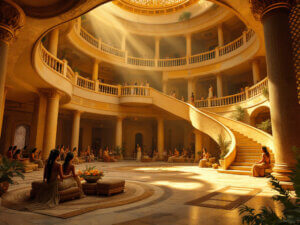
Minoan society was surprisingly advanced for its time, with a structured hierarchy and a thriving urban lifestyle.
Daily Life
Life in Minoan Crete was centered around their palatial complexes, which acted as administrative, economic, and cultural hubs. Homes were built with multi-storied designs, featuring amenities like running water and sanitation systems.
Social Hierarchy
- Elite Class: Likely included palace officials, priests, and wealthy merchants.
- Artisans and Craftspeople: Responsible for the intricate pottery, jewelry, and frescoes that the Minoans are famous for.
- Farmers and Laborers: Supported the society with agriculture and construction work.
Role of Women
Women in Minoan culture appear to have held a significant status, as depicted in frescoes and artifacts. They were often shown in positions of power, participating in religious ceremonies and public life.
Key Takeaway: The Minoans offer a rare glimpse into a society where women played prominent roles, contrasting with many other ancient civilizations.
Minoan Art and Architecture

The Minoans were remarkable for their artistic creativity and architectural ingenuity, leaving behind a rich cultural legacy that continues to captivate the modern world.
Minoan Palaces: Architectural Marvels
Minoan palaces were more than just royal residences—they were the heart of economic, administrative, and social life. The most famous of these is the Palace of Knossos, a sprawling complex believed to have housed up to 20,000 people at its peak.
Features of Minoan Palaces
- Labyrinthine Layout: The multi-level, interconnected rooms inspired the myth of the labyrinth.
- Sophisticated Engineering: Advanced drainage and water supply systems highlight the Minoans’ technical expertise.
- Central Courtyards: These open spaces were likely used for religious ceremonies, public gatherings, and even athletic events.
- Vibrant Decor: Walls were adorned with frescoes depicting nature, rituals, and daily life.
Knossos: A Closer Look
Located near modern-day Heraklion, the Palace of Knossos is a symbol of Minoan culture. Its frescoes, like the famous “Bull-Leaping Fresco,” offer insights into their society and beliefs.
Fun Fact: The word “labyrinth” is derived from “labrys,” a double-headed axe that symbolized Minoan power and was associated with the Palace of Knossos.
Minoan Art: A Celebration of Life
Minoan art reflects a love for nature, harmony, and the human experience. Unlike many other ancient civilizations, their artwork was less focused on war and conquest, emphasizing beauty and everyday life instead.
Frescoes
Minoan frescoes were created using the buon fresco technique, where pigments were applied to wet plaster, ensuring durability. Popular themes included:
- Floral and Marine Motifs: Lotus flowers, dolphins, and octopuses symbolized their close relationship with nature and the sea.
- Human Activity: Scenes of festivals, sports (like bull-leaping), and religious ceremonies depicted a dynamic society.
Pottery
Minoan pottery evolved through distinct styles, with the Kamares ware being particularly notable. These ceramics featured intricate patterns and vibrant colors, often used for trade.
Jewelry and Sculpture
Goldsmiths and artisans crafted intricate jewelry using techniques like granulation and filigree. Miniature sculptures, like the Snake Goddess figurines, showcase their religious and cultural symbolism.
Trade and Economy: The Lifeblood of Minoan Prosperity
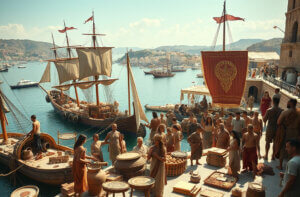
The Minoans didn’t just excel in art and architecture—they were master traders and savvy economic strategists. Their location on the island of Crete gave them a strategic advantage, allowing them to dominate trade routes and establish connections with neighboring civilizations across the Mediterranean.
A Strategic Location for Trade
Crete’s central position between Europe, Asia, and Africa made it a natural hub for commerce. The Minoans leveraged this advantage, building a maritime network that extended as far as Egypt and Mesopotamia.
Key Trading Partners
- Egypt: Traded luxury goods like gold, papyrus, and linen for Minoan olive oil, wine, and pottery.
- Mesopotamia: Imported precious metals and lapis lazuli while exporting artisan crafts.
- Cycladic and Aegean Islands: Engaged in robust trade of ceramics, textiles, and foodstuffs.
What Did the Minoans Trade?
The Minoans’ economy was built on a mix of agriculture, craftsmanship, and maritime trade. Here’s a breakdown of their primary exports and imports:
| Exports | Imports |
| Olive oil | Gold, silver |
| Wine | Exotic stones (lapis lazuli) |
| Pottery | Papyrus |
| Textiles | Precious metals |
| Jewelry and ornaments | Spices |
Craftsmanship as a Commodity
Minoan artisans were renowned for their skill, producing goods like pottery and jewelry that were highly sought after. Kamares ware, for instance, was traded widely due to its unique patterns and exceptional quality.
The Role of the Maritime Fleet
The Minoans were among the first civilizations to develop a significant naval presence, using advanced ships to transport goods and protect their trade routes. Their maritime expertise helped them maintain economic stability and foster cultural exchange.
The First Thalassocracy?
Historians often refer to the Minoans as one of the earliest examples of a thalassocracy, or sea-based empire. By dominating the waters of the Aegean, they exerted influence without relying heavily on military conquest.
Redistribution System: Palaces as Economic Centers
Minoan palaces, like Knossos and Phaistos, weren’t just administrative hubs—they also functioned as centers of economic activity. Goods produced in rural areas were brought to these complexes, stored, and redistributed as needed.
Linear A Tablets: Clues to Minoan Economy
Linear A, the undeciphered script of the Minoans, contains records believed to track economic transactions. Though not fully understood, these tablets hint at a sophisticated system of resource management.
Religion and Mythology: The Spiritual Heart of Minoan Life
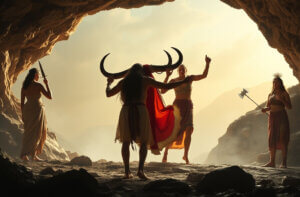
The Minoans’ religious practices and beliefs were central to their culture, shaping not only their art and architecture but also their daily lives. Their rituals, symbols, and mythology influenced later Greek traditions, leaving a spiritual legacy that endures to this day.
A Nature-Centered Religion
Minoan religion was deeply connected to nature. They worshipped deities associated with fertility, agriculture, and the natural world, reflecting their dependence on Crete’s abundant resources.
Key Features of Minoan Religion
- Polytheism: The Minoans worshipped multiple gods and goddesses, many of whom were later incorporated into Greek mythology.
- Sacred Symbols: Common symbols included:
- The Double Axe (Labrys): Representing power and possibly linked to female deities.
- The Bull: A symbol of strength and vitality, central to their rituals.
- The Snake: Connected to fertility and household protection.
- Natural Worship Sites: Shrines were often located in caves, on mountaintops, or near sacred trees.
Goddesses and the Prominence of Women in Religion
Minoan religion placed a strong emphasis on goddesses, indicating a matrifocal (female-centered) spiritual system.
- Snake Goddess Figurines: These iconic artifacts depict a female deity holding snakes, symbolizing renewal and protection.
- Role of Priestesses: Women played a prominent role in Minoan religious ceremonies, as depicted in frescoes and statues.
Key Insight: This focus on goddesses and female leaders reflects a unique societal structure where women were highly respected.
Rituals and Ceremonies
Minoan rituals were elaborate and often communal, involving music, dance, and offerings.
- Bull-Leaping: A ritualistic sport where participants vaulted over bulls, likely as a symbol of strength and divine connection.
- Offerings: Included food, pottery, and jewelry, placed at altars or in sacred caves.
- Sacrifices: Archaeological evidence suggests that animals, and possibly humans in rare instances, were sacrificed to appease the gods.
The Connection to Greek Mythology
Many aspects of Minoan religion found their way into Greek mythology.
- Minotaur and Labyrinth: The legend of the Minotaur, housed in a labyrinth, is believed to have roots in Minoan culture, possibly inspired by the Palace of Knossos and its association with bulls.
- Zeus and Crete: Greek mythology claims that Zeus, the king of the gods, was born in a cave on Crete, tying Minoan worship sites to later Greek beliefs.
The Fall of the Minoans: Unraveling the Mystery

The Minoan civilization thrived for centuries, but by around 1450 BCE, it had all but disappeared from history. The sudden decline of this advanced society has puzzled historians and archaeologists for decades. While no single explanation has emerged, several compelling theories shed light on the possible causes of their downfall.
1. Natural Disasters: The Fury of Nature
Crete’s location in a seismically active region made it vulnerable to earthquakes and volcanic activity.
The Eruption of Thera (Santorini)
One of the most popular theories links the Minoans’ decline to the massive eruption of the Thera volcano around 1600 BCE. This catastrophic event:
- Created a massive tsunami that devastated coastal settlements on Crete.
- Covered large areas of the region in volcanic ash, potentially damaging agriculture and trade.
- Disrupted the Minoans’ maritime network, weakening their economic power.
Did You Know?: The Thera eruption is one of the largest volcanic events in recorded history and is believed to have inspired myths like Atlantis.
Earthquakes
Frequent earthquakes in the region may have destroyed palaces and infrastructure, forcing the Minoans to repeatedly rebuild and diverting resources from other essential activities.
2. Invasion by Mycenaeans
Another leading theory suggests that the Minoans fell victim to external conquest. Around 1450 BCE, evidence points to the arrival of the Mycenaeans, a Greek-speaking civilization from mainland Greece.
- Mycenaeans likely took advantage of the weakened Minoans, establishing control over key sites like Knossos.
- After their arrival, Linear B script (used by the Mycenaeans) replaced the Minoans’ Linear A, signaling a cultural and administrative shift.
Key Insight: While the Mycenaeans adopted many aspects of Minoan culture, including art and religious symbols, their arrival marked the end of Minoan dominance.
3. Internal Decline
Some researchers propose that internal issues, such as political instability, resource depletion, or societal collapse, played a role in the Minoans’ downfall.
- Over-reliance on trade may have made them vulnerable to external disruptions.
- Environmental degradation, such as deforestation and soil erosion, could have reduced agricultural productivity.
- The redistribution system, reliant on palaces, may have faltered under stress.
Combination of Factors
It’s possible that the Minoans’ decline wasn’t due to a single event but a combination of interconnected factors:
- The eruption of Thera could have weakened the civilization.
- Subsequent invasions and internal struggles compounded the damage.
- Natural disasters like earthquakes may have delivered the final blow.
What Remained After Their Fall
Although the Minoans as a distinct civilization faded, their cultural and artistic achievements were preserved and adapted by the Mycenaeans.
- Minoan influence is evident in Mycenaean art, religion, and architecture.
- The myths and legends of Crete, such as the Minotaur, survived into the Greek era, ensuring their legacy lived on.
Legacy of The Minoans: Echoes Through Time
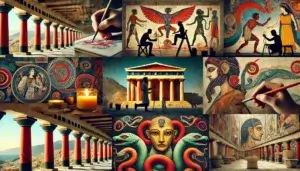
Though the Minoan civilization faded from prominence over 3,000 years ago, its influence continues to resonate in modern culture, architecture, and even mythology. Their innovative spirit, artistic achievements, and societal structures laid the groundwork for later civilizations, particularly the Mycenaeans and ancient Greeks.
1. Influence on Ancient Greece
The Minoans played a foundational role in shaping Greek culture, often regarded as the cradle of Western civilization.
Cultural and Religious Borrowing
- Art and Iconography: Minoan motifs, such as spirals, marine life, and nature scenes, were adopted by Mycenaean artists.
- Religious Practices: Elements of Minoan worship, including reverence for bulls and goddesses, influenced Greek religious traditions.
- Mythology: Myths like the Minotaur, Zeus’s birth on Crete, and the labyrinth reflect Minoan cultural memories.
2. Architectural Innovations
The Minoans’ sophisticated architecture served as inspiration for future builders.
- Open Courtyards: Central spaces in palaces influenced Greek and Roman public architecture.
- Advanced Infrastructure: Their use of drainage systems and multi-story buildings foreshadowed urban planning in later civilizations.
Fun Fact: The Palace of Knossos is sometimes called the “first European city” due to its complexity and size.
3. Maritime Legacy
The Minoans’ dominance as seafarers and traders set a precedent for Mediterranean commerce.
- Their maritime networks inspired later trade empires, including the Phoenicians and Greeks.
- The idea of a thalassocracy (sea-based power) became a hallmark of ancient civilizations.
4. Lessons for Today’s World
The Minoans offer valuable lessons for modern society:
- Sustainability: Their close relationship with nature and focus on agriculture emphasize the importance of balancing human needs with environmental stewardship.
- Cultural Exchange: Their thriving trade networks highlight how collaboration and exchange enrich societies.
- Resilience: Despite challenges like natural disasters, the Minoans rebuilt and innovated, reminding us of the power of adaptability.
5. Minoan Influence in Modern Times
Today, the Minoans continue to inspire:
- Art and Design: Minoan frescoes and pottery patterns are echoed in Mediterranean and contemporary art.
- Tourism: Sites like Knossos attract millions of visitors each year, preserving the memory of this remarkable civilization.
- Pop Culture: The legend of the Minotaur and the labyrinth remains a popular theme in literature, movies, and video games.
Conclusion
The Minoans may no longer exist, but their legacy endures as a testament to human ingenuity and resilience. Their advancements in art, architecture, and trade, coupled with their cultural impact, ensure they remain a vital part of our shared history.

